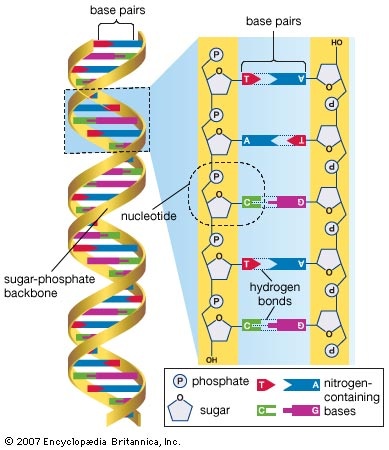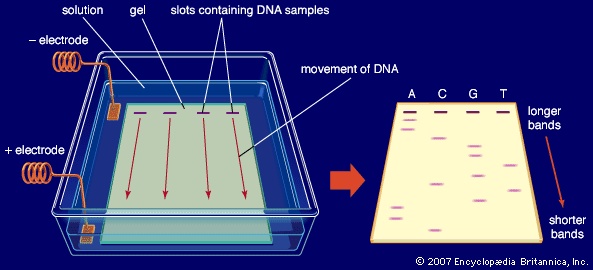DNA sequencing
genetics
 technique used to determine the nucleotide sequence of DNA (deoxyribonucleic acid). The nucleotide sequence is the most fundamental level of knowledge of a gene or genome. It is the blueprint that contains the instructions for building an organism, and no understanding of genetic function or evolution could be complete without obtaining this information.
technique used to determine the nucleotide sequence of DNA (deoxyribonucleic acid). The nucleotide sequence is the most fundamental level of knowledge of a gene or genome. It is the blueprint that contains the instructions for building an organism, and no understanding of genetic function or evolution could be complete without obtaining this information. The two basic sequencing approaches are the Maxam-Gilbert method, discovered by and named for American molecular biologists Allan M. Maxam and Walter Gilbert (Gilbert, Walter), and the Sanger method, discovered by English biochemist Frederick Sanger (Sanger, Frederick). In the most commonly used method, the Sanger method, DNA chains are synthesized on a template strand, but chain growth is stopped when one of four possible dideoxy nucleotides, which lack a 3' hydroxyl group, is incorporated, thereby preventing the addition of another nucleotide. A population of nested, truncated DNA molecules results that represents each of the sites of that particular nucleotide in the template DNA. These molecules are separated in a procedure called electrophoresis, and the inferred nucleotide sequence is deduced using a computer.
The two basic sequencing approaches are the Maxam-Gilbert method, discovered by and named for American molecular biologists Allan M. Maxam and Walter Gilbert (Gilbert, Walter), and the Sanger method, discovered by English biochemist Frederick Sanger (Sanger, Frederick). In the most commonly used method, the Sanger method, DNA chains are synthesized on a template strand, but chain growth is stopped when one of four possible dideoxy nucleotides, which lack a 3' hydroxyl group, is incorporated, thereby preventing the addition of another nucleotide. A population of nested, truncated DNA molecules results that represents each of the sites of that particular nucleotide in the template DNA. These molecules are separated in a procedure called electrophoresis, and the inferred nucleotide sequence is deduced using a computer.Knowledge of the sequence of a DNA segment has many uses. First, it can be used to find genes, segments of DNA that code for a specific protein or phenotype. If a region of DNA has been sequenced, it can be screened for characteristic features of genes. For example, open reading frames (ORFs)—long sequences that begin with a start codon (three adjacent nucleotides; the sequence of a codon dictates amino acid production) and are uninterrupted by stop codons (except for one at their termination)—suggest a protein-coding region. Also, human genes are generally adjacent to so-called CpG islands—clusters of cytosine and guanine, two of the nucleotides that make up DNA. If a gene with a known phenotype (such as a disease gene in humans) is known to be in the chromosomal region sequenced, then unassigned genes in the region will become candidates for that function. Second, homologous DNA sequences of different organisms can be compared in order to plot evolutionary relationships both within and between species. Third, a gene sequence can be screened for functional regions. In order to determine the function of a gene, various domains can be identified that are common to proteins of similar function. For example, certain amino acid sequences within a gene are always found in proteins that span a cell membrane (cell); such amino acid stretches are called transmembrane domains. If a transmembrane domain is found in a gene of unknown function, it suggests that the encoded protein is located in the cellular membrane. Other domains characterize DNA-binding proteins. Several public databases of DNA sequences are available for analysis by any interested individual.
- Rothermere, Harold Sidney Harmsworth, 1st Viscount, Baron Rothermere Of Hemsted
- Rothesay
- Roth, Henry
- Roth, Joseph
- Roth, Klaus Friedrich
- Rothko, Mark
- Roth, Philip
- Rothschild family
- Rothschild, Lionel Walter Rothschild, 2nd Baron
- Rothstein, Arnold
- rotifer
- Roti Island
- Rotimi, Ola
- rotogravure printing
- Rotorua
- Rotorua, Lake
- Rotrou, Jean de
- rotta
- rotten borough
- Rotterdam
- Rottnest Island
- Rottweiler
- Rotuma Island
- rotunda
- Rouault, Georges